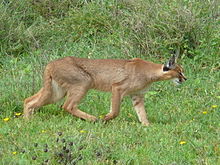African Caracal Lynx
The caracal is a slender, yet muscular, cat with long legs and a short tail. Males typically weigh 13 to 18 kilograms (29 to 40 lb) while females weigh about 11 kilograms (24 lb). The caracal resembles a Eurasian Lynx and for a long time it was considered a close relative of the lynxes. It has a tail nearly a third of its body length and both sexes look the same. The caracal is 65 to 90 centimeters (26 to 35 in) in length with a 30 centimeters (12 in) tail. Compared to lynxes, it has longer legs, shorter fur, and a slimmer appearance.
The colour of the fur varies between wine-red, gray, or sand-colored. Melanistic (black) caracals also occur. Young caracals bear reddish spots on the underside; adults do not have markings except for black spots above the eyes and small white patches around the eyes and nose. Underparts of chin and body are white and a narrow black line runs from the corner of the eye to the nose.
The pupils of a caracal’s eyes contract to form circles rather than the slits found in most small cats. The most conspicuous feature of the caracal is elongated, tufted black ears which also explain the origin of its name, karakulak, Turkish for “black ear.” A juvenile has black on the outside of the ears which disappears as it becomes an adult. Its ears, which it uses to locate prey, are controlled by 29 different muscles.
The feet of a caracal have numerous stiff hairs growing between the pads. These probably help the animal walk on soft sand. The jaw is short and equipped with powerful teeth. About 92 percent of caracals lack the second upper premolar teeth.
Habitat
The caracal is distributed over Africa and the Middle East. Its chief habitat is dry steppes and semi deserts, but it also  inhabits woodlands, savannah, and scrub forest. They generally prefer open country so long as there is sufficient cover in the form of bushes and rocks from which to ambush prey.
inhabits woodlands, savannah, and scrub forest. They generally prefer open country so long as there is sufficient cover in the form of bushes and rocks from which to ambush prey.
Its life expectancy is 12 years in the wild, 17 years in captivity. The caracal may survive without drinking for a long period — the water demand is satisfied with the body fluids of its prey. Since it is also surprisingly easy to tame, it has been used as a hunting cat in Iran and India.
Behavior and diet
Adult caracals dwell either alone or, less commonly, in pairs. Females inhabit relatively small home ranges, varying  from 5 to 57 square kilometers (1.9 to 22 sq mi) depending on the local availability of prey. While the females actively defend their territory against other females, the males roam over much larger areas of 19 to 220 square kilometers (7.3 to 85 sq mi) with considerable overlap.
from 5 to 57 square kilometers (1.9 to 22 sq mi) depending on the local availability of prey. While the females actively defend their territory against other females, the males roam over much larger areas of 19 to 220 square kilometers (7.3 to 85 sq mi) with considerable overlap.
Like other cats, caracals scent mark their territory. They leave their feces in visible locations and also mark territory by spraying urine onto bushes or logs or raking it into the ground with their hind feet.
Caracals hunt by stalking their prey, approaching within about 5 metes (16 ft) before suddenly sprinting and leaping. They kill smaller prey with a bite to the nape of the neck and larger animals by biting the throat then raking with their claws. Caracals sometimes cover their larger prey if they cannot consume the whole carcass in a single meal and return to it later. Some have even been observed to hide carcasses in trees.
It is best known for its spectacular skill at hunting birds, able to snatch a bird in flight, sometimes more than one at a time. It can jump and climb exceptionally well, enabling it to catch hyraxes better than probably any other carnivore. If no cover is available in which to conceal itself, a caracal may flatten itself against the ground and remain motionless, allowing its coat color to act as camouflage.
Caracals produce the usual range of sounds for cats including growling, hissing, purring, and calling. Unusually, they also make a barking sound which is possibly used as a warning.
Reproduction and life cycle
Mating may occur at any time of year. However, it is more likely to occur when prey is plentiful which stimulates estrous in females. The estrous cycle lasts two weeks and is marked by the female spraying urine containing chemical cues advertising her receptivity to neighboring males.
The female typically mates with several males over the course of a number of days. In some areas, males have been observed to fight aggressively for access to females and remain with her for several days to guard against rivals, while in others they appear to be less protective. Copulation can last from ninety seconds to ten minutes.
Gestation lasts from sixty-one to eighty-one days and litter size ranges from one to six kittens. For litters born in their natural environment, the maximum number of kittens is three, however larger litters are more likely to occur in captivity where nutrition needs are adequately met. Before birth, the female prepares a den in a cave or other sheltered area, sometimes using the abandoned burrows of other animals. At birth, the kittens are blind and helpless, weigh 198 to 250 grams (7.0 to 8.8 oz), and have yellow to reddish brown fur with black markings. The eyes open at around ten days and the deciduous teeth have fully developed by fifty days. The canines are the first permanent teeth to appear, at around four or five months, with the others following over the next six months.
Kittens are able to leave the birthing den at around one month old and at about this time the mother will begin regularly moving them to new locations. Kittens are weaned at about ten weeks but may stay with their mother for up to one year when they start to reach sexual maturity. Life expectancy in the wild is twelve years and seventeen years in captivity.
